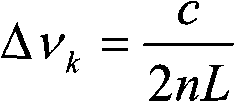Method and devices for optically generating high-frequency microwave signals
A high-frequency microwave and signal technology, applied in the field of microwave photonics, can solve problems such as complex design and production, difficulty in generating microwave signals, and unstable microwave signals, and achieve low-cost effects
- Summary
- Abstract
- Description
- Claims
- Application Information
AI Technical Summary
Problems solved by technology
Method used
Image
Examples
Embodiment Construction
[0026] specific implementation plan
[0027] Such as figure 1 As shown, a device for optically generating high-frequency microwave signals includes a laser pump source 1 with a wavelength of 980nm, a 980nm / 1550nm optical wavelength division multiplexer 2, a polarization controller 6, a polarizer 7, a photodetector 8, a high-gain Polarization-maintaining fiber 4, the two ends of the high-gain polarization-maintaining fiber 4 are engraved with fiber Bragg gratings 3 and 5 with wavelength matching and the same period respectively, wherein the fiber Bragg grating 3 close to the 980nm / 1550nm wavelength division multiplexer 2 is a reflectivity A fiber Bragg grating with a low reflectivity of 50-70%, and another fiber Bragg grating 5 is a fiber Bragg grating with a high reflectivity greater than 99%. The pump end of the 980nm / 1550nm optical wavelength division multiplexer 2 is connected to the laser pump source 1 with a wavelength of 980nm, the common end is optically connected to t...
PUM
| Property | Measurement | Unit |
|---|---|---|
| reflectance | aaaaa | aaaaa |
| reflectance | aaaaa | aaaaa |
| refraction | aaaaa | aaaaa |
Abstract
Description
Claims
Application Information
 Login to View More
Login to View More - R&D
- Intellectual Property
- Life Sciences
- Materials
- Tech Scout
- Unparalleled Data Quality
- Higher Quality Content
- 60% Fewer Hallucinations
Browse by: Latest US Patents, China's latest patents, Technical Efficacy Thesaurus, Application Domain, Technology Topic, Popular Technical Reports.
© 2025 PatSnap. All rights reserved.Legal|Privacy policy|Modern Slavery Act Transparency Statement|Sitemap|About US| Contact US: help@patsnap.com



